 Technology peripherals
Technology peripherals
 AI
AI
 The guy from Hangzhou Electronics is the first to get the GPT image reading function. A single card can realize the new SOTA. The code has been open source
The guy from Hangzhou Electronics is the first to get the GPT image reading function. A single card can realize the new SOTA. The code has been open source
The guy from Hangzhou Electronics is the first to get the GPT image reading function. A single card can realize the new SOTA. The code has been open source
Currently, this paper has been accepted by CVPR2023.
GPT-4, which can read images, is shockingly released! But you have to queue up to use it. . .
Why not try this first~
Add a small model, you can make large language models such as ChatGPT and GPT-3 that can only understand text easilyRead pictures, all kinds of tricky details can be dealt with easily.
And train this small modelIt can be done with a single card (an RTX 3090).
As for the effect, just look at the picture.
For example, input a picture of a "music scene" to the trained GPT-3 and ask it: What activities are being held at the scene?
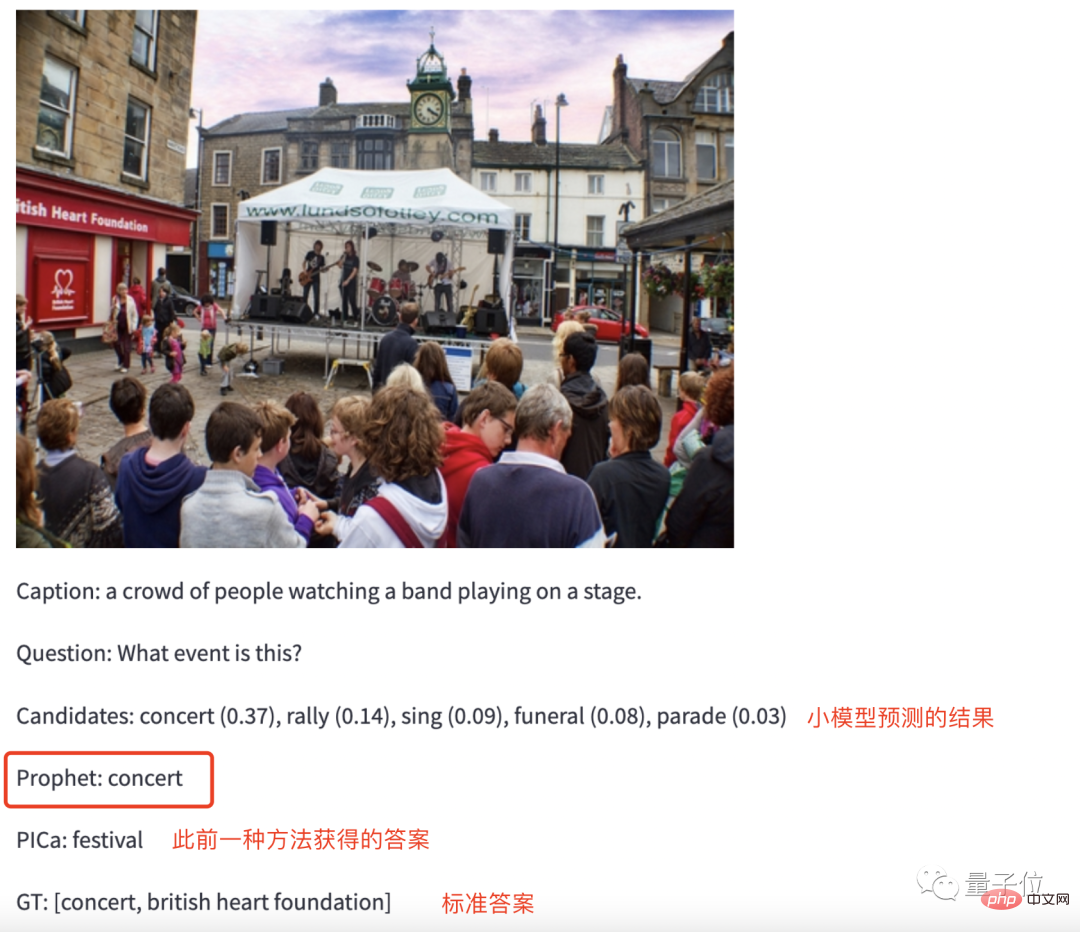
Without any hesitation, GPT-3 gave the answer to Concert.
To make it more difficult, give GPT-3 a photo of Jiang Zi and let it identify what type of material the curtain in the photo is.
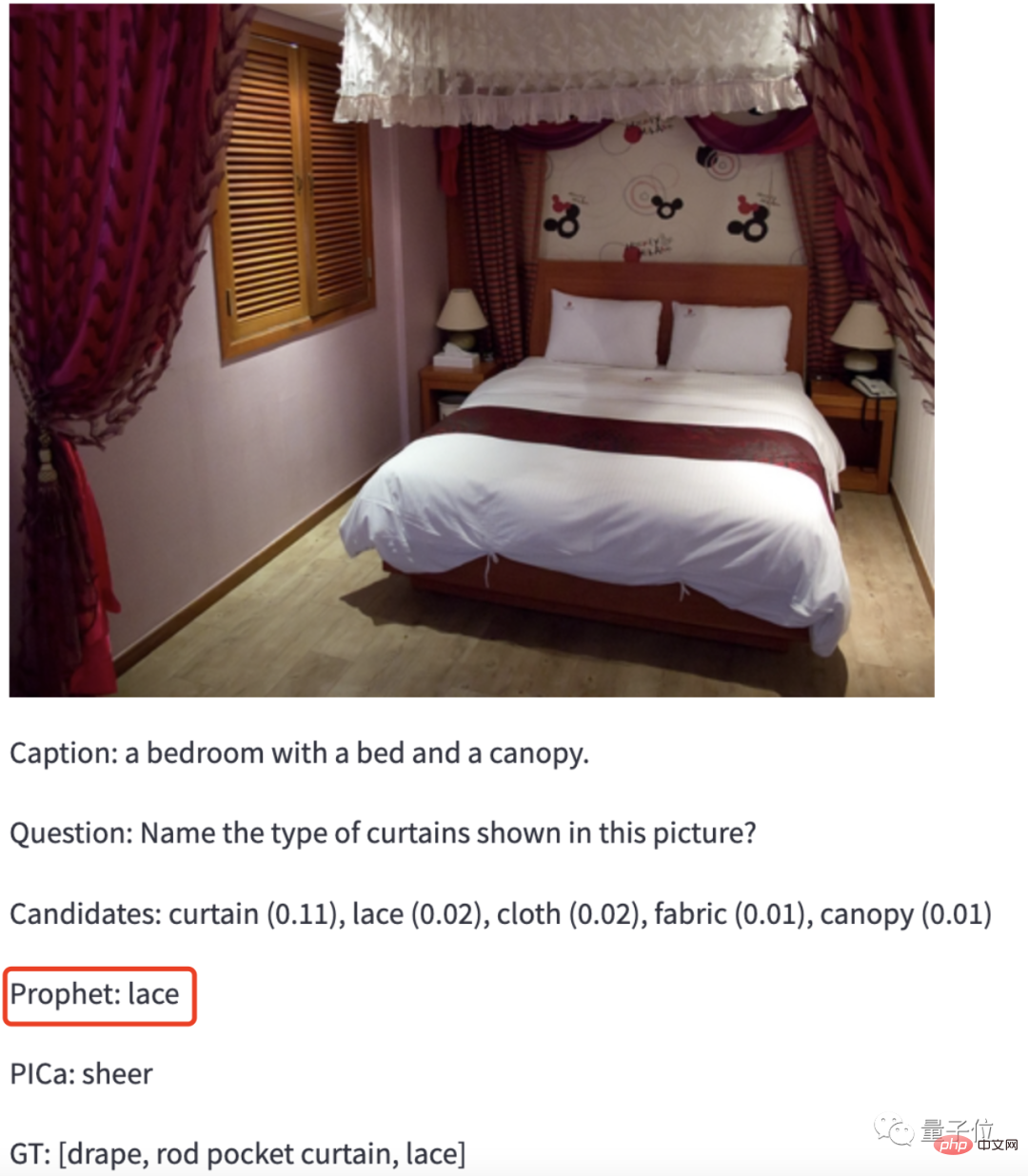
GPT-3: lace.
Bingo! (It seems that there is something on it)
This method is the latest result of a team from Hangzhou University of Electronic Science and Technology and Hefei University of Technology: Prophet, which they had already developed half a year ago Get to work on this.
The first author of the paper is Shao Zhenwei, a graduate student of Hangzhou Dianzi University. He was diagnosed with "progressive spinal muscular atrophy" when he was 1 year old. He regretted not passing Zhejiang University during the college entrance examination and chose Hangzhou Dianzi University, which is close to home. .
This paper has been accepted by CVPR2023.
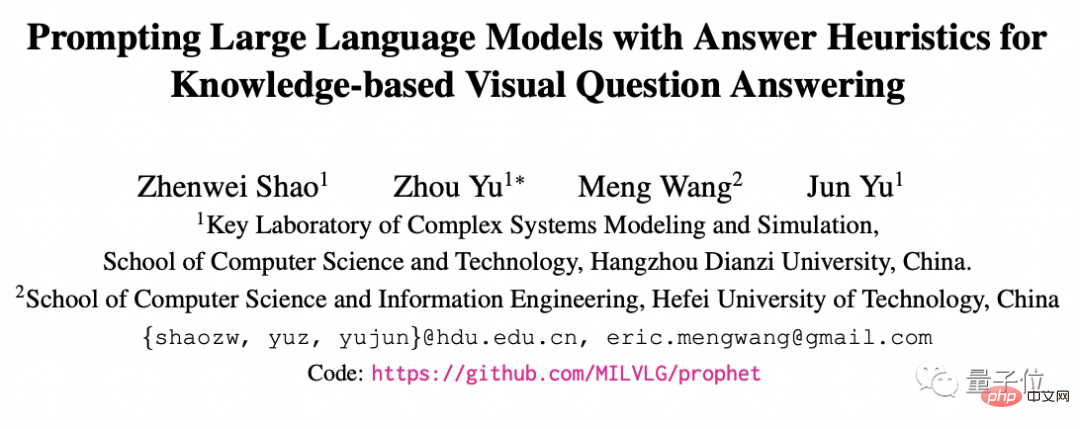
Reaching the new SOTA in cross-modal tasks
Without further ado, let’s look directly at the reading of GPT-3 with the support of Prophet’s method. Figure ability.
Let’s first take a look at its test results on the data set.
The research team tested Prophet on two visual question and answer data sets based on external knowledge, OK-VQA and A-OKVQA, and both created new SOTA.
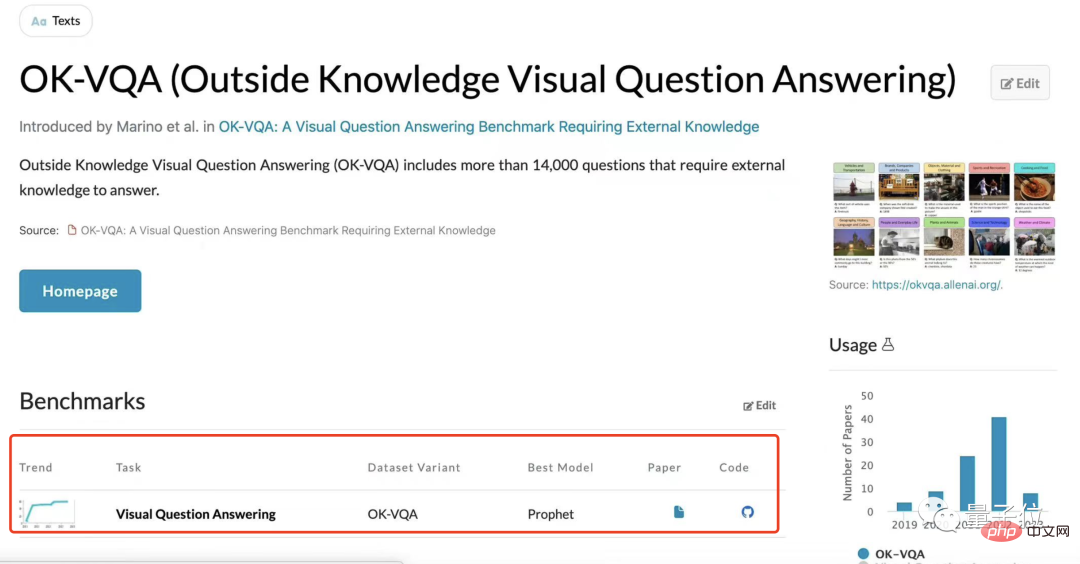
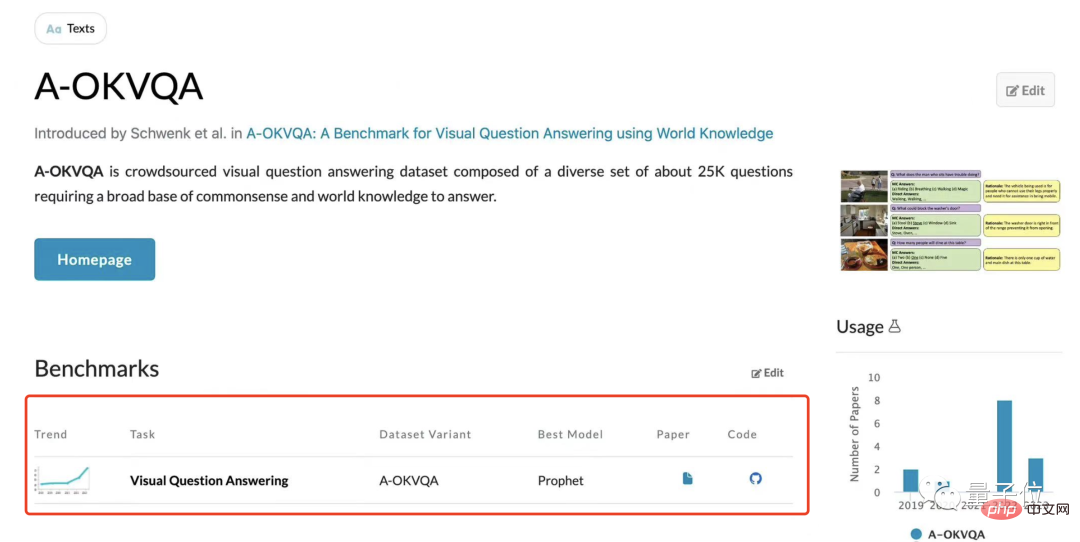
More specifically, on the OK-VQA data set, compared with Deepmind’s large model Flamingo with 80B parameters, Prophet reached Achieved an accuracy rate of 61.1%, successfully defeating Flamingo (57.8%).
And in terms of required computing power resources, Prophet also "beats" Flamingo.
Flamingo-80B needs to be trained on 1536 TPUv4 graphics cards for 15 days, while Prophet only requires one RTX-3090 graphics card to train the VQA model 4 days, then call the OpenAI API a certain number of times.
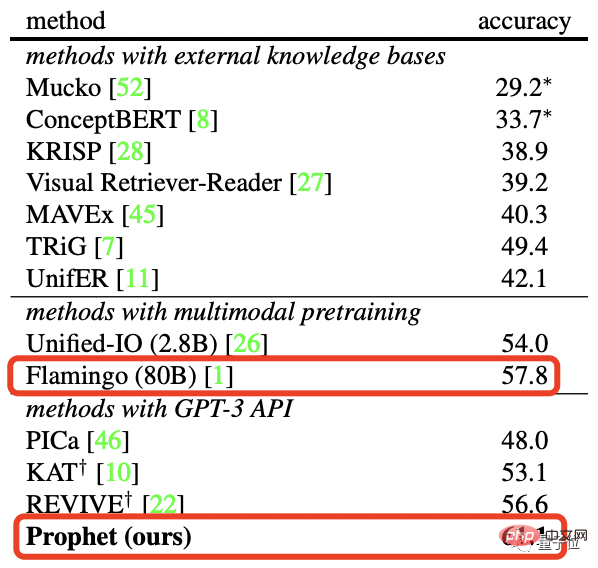
In fact, there have been methods similar to Prophet to help GPT-3 handle cross-modal tasks before, such as PICa, and later KAT and REVIVE.
However, they may not be satisfactory in handling some details.
Give a chestnut, let them read the picture below together, and then answer the question: What kind of fruit will the tree in the picture bear?
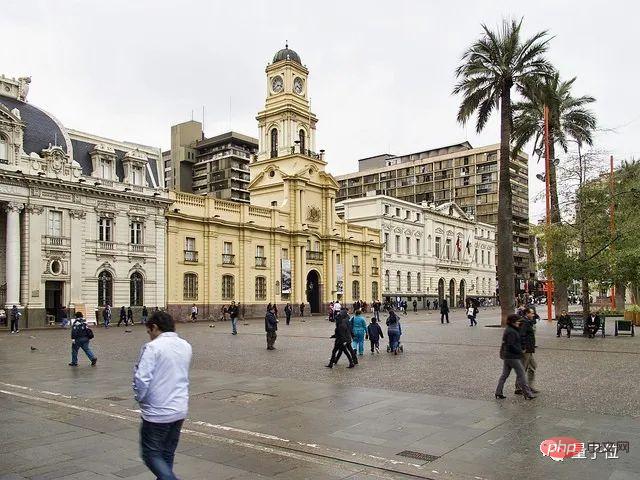
The only information that PICa, KAT and REVIVE extracted from the picture was: a group of people walking in the square, completely ignoring that there was a coconut tree behind. The final answer can only be guessed.
This situation will not happen with Prophet. It solves the problem of insufficient image information extracted by the above method and further stimulates the potential of GPT-3.
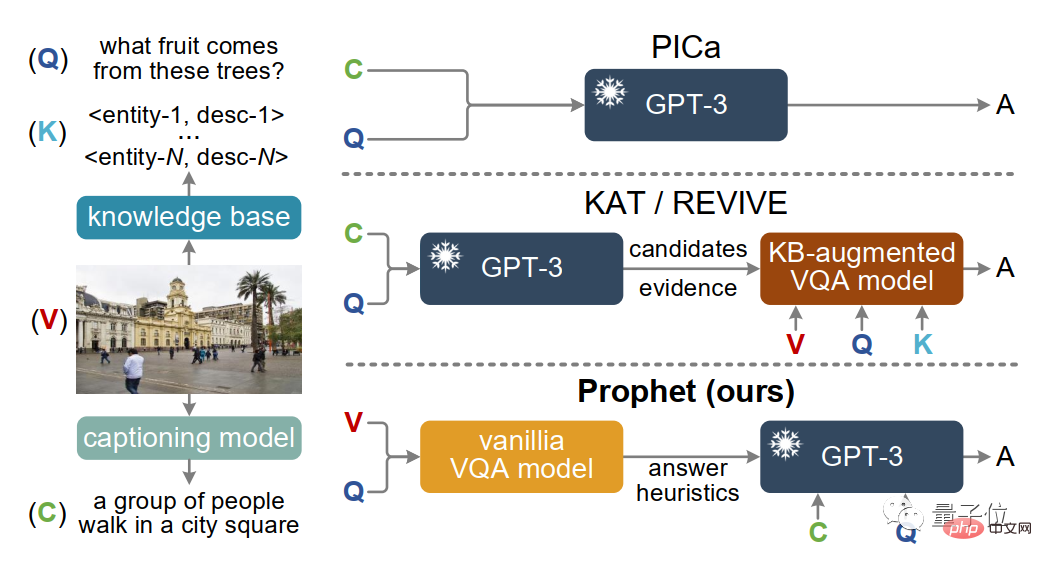
So how did Prophet do it?
Small model Big model
Effectively extract information and accurately answer questions. Prophet relies on its unique two-stage framework to be able to do this.
The division of labor between these two stages is also clear:
- The first stage: Give some enlightening answers based on the questions;
- The second stage: These answers will narrow the scope, giving GPT-3 sufficient space to realize its potential.
First, in the first stage, the research team trained an improved MCAN model (a VQA model) against a specific external knowledge VQA data set.
After training the model, extract two heuristic answers from it: answer candidates and answer-aware examples.
Among them, Answer candidates are sorted based on the confidence level output by the model classification layer, and the top10 are selected.
Answer perception example refers to using the features before the model classification layer as the potential answer features of the sample, the most similar labeled sample in this feature space.

The next step is the second stage, which is relatively simple and crude.
Organize the "inspiring answers" obtained in the previous step into prompts, and then input the prompts to GPT-3 to complete visual question and answer questions under certain prompts.
However, although some answer hints have been given in the previous step, this does not mean that GPT-3 will be limited to these answers.
If the confidence of the answer given by the prompt is too low or the correct answer is not among those prompts, it is entirely possible for GPT-3 to generate a new answer.
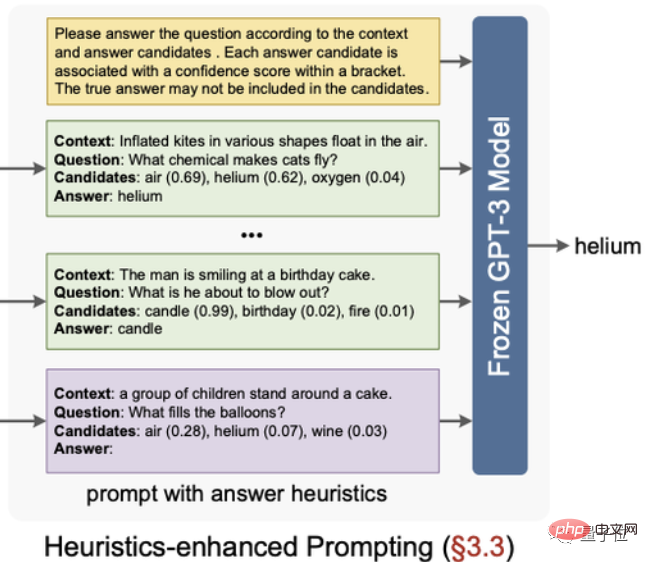
Research Team
Of course, in addition to the research results, the team behind this study also has to be mentioned.
First authorShao Zhenwei was diagnosed with "progressive spinal muscular atrophy" when he was 1 year old. It is a first-level physical disability and has no ability to take care of itself. Life and study require the full care of the mother. .
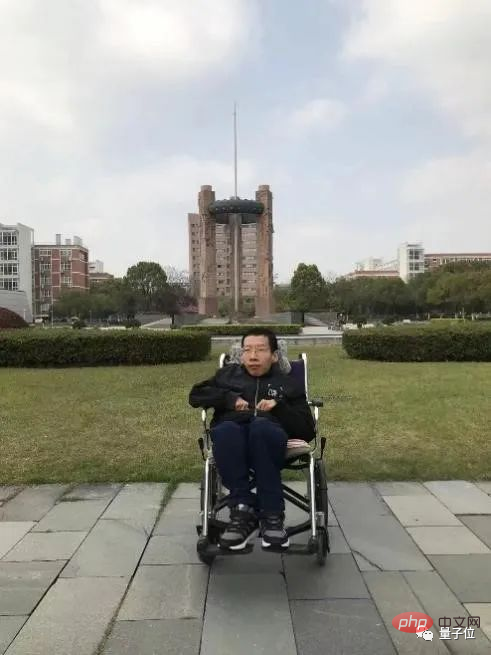
However, despite his physical limitations, Shao Zhenwei’s thirst for knowledge has not weakened.
In the 2017 college entrance examination, he scored a high score of 644 points and was admitted to the computer major of Hangzhou University of Electronic Science and Technology with the first place.
During this period, he also won honors such as the 2018 Chinese College Student Self-improvement Star, the 2020 National Scholarship, and the 2021 Zhejiang Province Outstanding Graduate.
During his undergraduate period, Shao Zhenwei had already started to conduct scientific research activities with Professor Yu Zhou.
In 2021, Shao Zhenwei had a chance encounter with Zhejiang University when he was preparing for postgraduate promotion, so he stayed at the school and joined Professor Yu Zhou’s research group to pursue a master’s degree. Currently, he is in the second year of graduate school, and his research direction is cross-modal learning.
Professor Yu Zhou is the second author and corresponding author of this research paper. He is the youngest professor at the School of Computer Science of Hangzhou Dianping University and a member of the “Complex System Modeling and Simulation” Laboratory of the Ministry of Education. deputy director.
For a long time, Yu Zhou has specialized in the multimodal intelligence direction, and has led the research team to win the championship and runner-up in the international visual question answering challenge VQA Challenge many times.

Most members of the research team are in Hangzhou Electronics Media Intelligence Laboratory (MIL).
The laboratory is headed by Professor Yu Jun, a National Distinguished Talent. In recent years, the laboratory has published a series of high-level journal conference papers (TPAMI, IJCV, CVPR, etc.) focusing on multi-modal learning, and has won many IEEE journal awards. Best paper award at the conference.
The laboratory has hosted more than 20 national projects such as the National Key R&D Plan and the National Natural Science Foundation of China. It has won the first prize of Zhejiang Province Natural Science Award and the second prize of Educational Natural Science Award.
The above is the detailed content of The guy from Hangzhou Electronics is the first to get the GPT image reading function. A single card can realize the new SOTA. The code has been open source. For more information, please follow other related articles on the PHP Chinese website!

Hot AI Tools

Undresser.AI Undress
AI-powered app for creating realistic nude photos

AI Clothes Remover
Online AI tool for removing clothes from photos.

Undress AI Tool
Undress images for free

Clothoff.io
AI clothes remover

AI Hentai Generator
Generate AI Hentai for free.

Hot Article

Hot Tools

Notepad++7.3.1
Easy-to-use and free code editor

SublimeText3 Chinese version
Chinese version, very easy to use

Zend Studio 13.0.1
Powerful PHP integrated development environment

Dreamweaver CS6
Visual web development tools

SublimeText3 Mac version
God-level code editing software (SublimeText3)

Hot Topics
 1376
1376
 52
52
 Laravel's geospatial: Optimization of interactive maps and large amounts of data
Apr 08, 2025 pm 12:24 PM
Laravel's geospatial: Optimization of interactive maps and large amounts of data
Apr 08, 2025 pm 12:24 PM
Efficiently process 7 million records and create interactive maps with geospatial technology. This article explores how to efficiently process over 7 million records using Laravel and MySQL and convert them into interactive map visualizations. Initial challenge project requirements: Extract valuable insights using 7 million records in MySQL database. Many people first consider programming languages, but ignore the database itself: Can it meet the needs? Is data migration or structural adjustment required? Can MySQL withstand such a large data load? Preliminary analysis: Key filters and properties need to be identified. After analysis, it was found that only a few attributes were related to the solution. We verified the feasibility of the filter and set some restrictions to optimize the search. Map search based on city
 How to solve mysql cannot be started
Apr 08, 2025 pm 02:21 PM
How to solve mysql cannot be started
Apr 08, 2025 pm 02:21 PM
There are many reasons why MySQL startup fails, and it can be diagnosed by checking the error log. Common causes include port conflicts (check port occupancy and modify configuration), permission issues (check service running user permissions), configuration file errors (check parameter settings), data directory corruption (restore data or rebuild table space), InnoDB table space issues (check ibdata1 files), plug-in loading failure (check error log). When solving problems, you should analyze them based on the error log, find the root cause of the problem, and develop the habit of backing up data regularly to prevent and solve problems.
 How to set the timeout of Vue Axios
Apr 07, 2025 pm 10:03 PM
How to set the timeout of Vue Axios
Apr 07, 2025 pm 10:03 PM
In order to set the timeout for Vue Axios, we can create an Axios instance and specify the timeout option: In global settings: Vue.prototype.$axios = axios.create({ timeout: 5000 }); in a single request: this.$axios.get('/api/users', { timeout: 10000 }).
 How to use mysql after installation
Apr 08, 2025 am 11:48 AM
How to use mysql after installation
Apr 08, 2025 am 11:48 AM
The article introduces the operation of MySQL database. First, you need to install a MySQL client, such as MySQLWorkbench or command line client. 1. Use the mysql-uroot-p command to connect to the server and log in with the root account password; 2. Use CREATEDATABASE to create a database, and USE select a database; 3. Use CREATETABLE to create a table, define fields and data types; 4. Use INSERTINTO to insert data, query data, update data by UPDATE, and delete data by DELETE. Only by mastering these steps, learning to deal with common problems and optimizing database performance can you use MySQL efficiently.
 Remote senior backend engineers (platforms) need circles
Apr 08, 2025 pm 12:27 PM
Remote senior backend engineers (platforms) need circles
Apr 08, 2025 pm 12:27 PM
Remote Senior Backend Engineer Job Vacant Company: Circle Location: Remote Office Job Type: Full-time Salary: $130,000-$140,000 Job Description Participate in the research and development of Circle mobile applications and public API-related features covering the entire software development lifecycle. Main responsibilities independently complete development work based on RubyonRails and collaborate with the React/Redux/Relay front-end team. Build core functionality and improvements for web applications and work closely with designers and leadership throughout the functional design process. Promote positive development processes and prioritize iteration speed. Requires more than 6 years of complex web application backend
 Can mysql return json
Apr 08, 2025 pm 03:09 PM
Can mysql return json
Apr 08, 2025 pm 03:09 PM
MySQL can return JSON data. The JSON_EXTRACT function extracts field values. For complex queries, you can consider using the WHERE clause to filter JSON data, but pay attention to its performance impact. MySQL's support for JSON is constantly increasing, and it is recommended to pay attention to the latest version and features.
 The primary key of mysql can be null
Apr 08, 2025 pm 03:03 PM
The primary key of mysql can be null
Apr 08, 2025 pm 03:03 PM
The MySQL primary key cannot be empty because the primary key is a key attribute that uniquely identifies each row in the database. If the primary key can be empty, the record cannot be uniquely identifies, which will lead to data confusion. When using self-incremental integer columns or UUIDs as primary keys, you should consider factors such as efficiency and space occupancy and choose an appropriate solution.
 Understand ACID properties: The pillars of a reliable database
Apr 08, 2025 pm 06:33 PM
Understand ACID properties: The pillars of a reliable database
Apr 08, 2025 pm 06:33 PM
Detailed explanation of database ACID attributes ACID attributes are a set of rules to ensure the reliability and consistency of database transactions. They define how database systems handle transactions, and ensure data integrity and accuracy even in case of system crashes, power interruptions, or multiple users concurrent access. ACID Attribute Overview Atomicity: A transaction is regarded as an indivisible unit. Any part fails, the entire transaction is rolled back, and the database does not retain any changes. For example, if a bank transfer is deducted from one account but not increased to another, the entire operation is revoked. begintransaction; updateaccountssetbalance=balance-100wh



